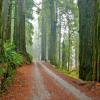So being from California, "The land of fruits and nuts", I have always been enamored with Redwood trees. I grew up in the city of Redwood City, CA if that should be any indication. Recently, after a trip to Jedediah Smith State Park in the north of the state, a moist, cool rain forest, I noticed that after being there for a few hours, all my stress had melted away. My mental fog stemming from Narcolepsy and other issues seemed to be temporarily lifted and my mood returned, if ever so briefly, to my preillness state. That day, my wife and I hiked 14.5 miles and I hadn't felt so good in years. Being a sincere, if undereducated, student of the human mind, I immediately became curious as to what could have caused this experience.
I scoured the internet for a scholarly analysis of the Redwoods themselves, as I haven't gotten this feeling from other types of forests I've been in. The only two sources I could find was this abstract from Iran, which only examined the leaves:
Journal: IRANIAN JOURNAL OF MEDICINAL AND AROMATIC PLANTS 2002 , Volume - , Number 18; Page(s) 23 To 42. Paper: COMPARISON BETWEEN OIL COMPOSITION OF SEQUOIA SEMPERVIRENS FROM TISSUE CULTURE AND MAIN SAMPLE Author(s): SEFIDKON F., MESHKIZADEH S., SHAHRZAD SH. * Abstract:Keyword(s): SEQUOIA SEMPERVIRENS, ESSENTIAL OIL, α- PINENE, LIMONENE, α- TERPINENEY1 ACETATE, SABINENESequoia is a very big and ever green tree with 45-90 meter height. It is native to the side of Atlantic Ocean, Which is also cultivated in Iran. The plant materials were collected from one of the Sequoia trees from Rezvanshahr Garden in August. The height to this tree was 40 meter and it was 30 years old.
For preparation of tissue culture samples, the end part of shoots in 1-2 centimeter length has been cultivated.
The leaves from main tree and also tissue culture sample were hydrodistilled for their essential oils. The oils were analyzed by combination of capillary GC and GC/MS.
72 Compounds were identified in the leaf oil of main tree and 37 compounds were characterized in the leaf oil of tissue culture sample. The main components of the oil from main tree were b- phellandrene and limonene (13.30%), a- pinene (6.83%), terpinene -4-o1 (6.47%), g-teroubebe *5.44%) and germacrene B (4.17%), while the major components of the oil from tissue culture sample were a- pinene (26.30%), a- terpinenyl acetate (14.40%), sabinene (13.60%), g- terpinene (7.10%), germacrene D (6.90%), b-phellandrene and limonene (6.60 %) and p-cymene (5.00%). Althoug these components were found in both oils, but the higher percentage of some useful compounds in the oil of tissue culture sample, gave it more effective character.
Aside from that, I found a really old (1912!) study from Berkeley regarding an analysis of the essential oil compounds: https://archive.org/...verich_djvu.txt
I know there's more involved though. I'm aware the bark is highly antifungal, and as I've had mold exposure in the past, this might have helped with any leftover mold in my body. However, besides Pinene, I'd really like to know what phytoconstituent is capable of giving that mental clarity amongst the moist trees, the fern undergrowth, and the bed of leaf pelt covering the floor. Anyone have any idea? Does anybody get a similar feeling from being out in a specific forest setting?
















































